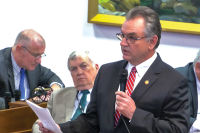A ‘free atmosphere to create’: Cherokee art school doubles its enrollment
Brian Kane used to teach someone else’s curriculum in someone else’s department at some other college.
Unsatisfied with his situation, however, Kane accepted a position at Oconaluftee Institute of Cultural Arts in Cherokee, where he and his students have a “free atmosphere to create,” he said.
Kane is the only full-time faculty member at the 10-student art institute, though four others regularly teach there.
The school is a nuts and bolts operation, located in a large warehouse off U.S. 19 in Cherokee. A small exhibit area at the entrance distinguishes it from the rest of the school, which is divided up into classrooms and collaborative work areas with white particleboard.
“It’s a studio environment,” said Jeff Marley, OICA’s program coordinator, adding that the size of the program makes it much more “hands on” and individualized.
The Oconaluftee Institute is a one-of-a-kind (or at least one of few) school that emphasizes Native American, particularly Cherokee, art history.
Related Items
“There is nothing like this east of the Mississippi,” Kane said. “We’re trying to bring this cultural aspect into the arts.”
The art institute was established because leaders of the Eastern Band of Cherokee Indians wanted to offer some type of higher education on the reservation.
“There was a desire by tribal members to have a tribal college,” Marley said. “They wanted more focus on Cherokee (art).”
Although the idea began germinating in 2002, the art institute offered its first classes in 2007. Students can get their associate’s degree in art at the school and finish their bachelor’s degree at Western Carolina University or Southern Community College.
Although the Cherokee art school is already partnered with the community college, SCC will formally integrate and fund the program once it grows to 25 pupils. Currently, the Eastern Band gives about $150,000 to the art institute, and it receives an additional $500,000 in grants, which it applies for throughout the year.
“We were charged with seeking other funding, and we have,” Marley said.
The school has also reduced its budget by $11,000 — nearly $4,300 of which came from cutting its utility usage.
Unique experiences
OICA offers an inexpensive alternative to state or private colleges and universities. Five semesters — the time is takes to complete an associate’s degree — costs $3,962 at the Cherokee art school.
Anyone can apply; students do not have to be members of the tribe to study at the institute.
“Although we are a cultural program, all of our students might not be from tribal backgrounds,” Marley said.
Because of its connection to the Eastern Band, the school can give its students unique experiences. Several weeks ago, it was a private tour of The Museum of the Cherokee Indian to view art that was thousands of years old, pieces that are currently held in storage.
“Our students got to see and touch exhibits that are not open to the public,” Marley said.
During the past three years, the program has doubled its student population. It will graduate its third student this spring and another four or five in the next couple years.
Because the institute is so small, the program can be more “flexible,” Marley said.
Classes can change their schedule to be compatible with the availability of visiting artists, such as Native American painter and photographer Shan Goshorn.
For instance, students typically learn to shape clay first using only their hands and small paddles, which can add texture and imprints to the pottery. Only after that do they learn to make ceramics using a pottery wheel.
However, recent scheduling conflicts forced instructors to flip the ceramics curriculum on its head — a considerably easier task at a small school.
In addition to ceramics, the institute specializes in three other areas of study: sculpture, weaving and printmaking. It may eventually add painting and photography to its repertoire, but the institute wanted to focus initially on traditional forms of art.
OCIA acquired a printing press last year, which allowed them to expand their printmaking. What is unique about the institute’s press is that students can print items in either Roman letters or syllabary, the Cherokee written language.
Students have “the capacity to do anything they want,” Marley said. “What you can do with bookmaking and printmaking opens wide up with this press.”
Student art on display
The art institute will be showcasing its student art from Dec. 1 thru Dec. 16 and will hold a reception Dec. 5 from 5 to 7 p.m. The reception will include music, refreshments and a silent auction to benefit the school. Students will also be on-hand to talk about their art.









